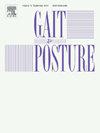Inter-segmental foot motion during gait in end-stage lesser tarsometatarsal joint osteoarthritis: A comparative study using multi-segment foot model
IF 2.2
3区 医学
Q3 NEUROSCIENCES
引用次数: 0
Abstract
Objectives
The purpose of this study was to evaluate inter-segmental foot and ankle kinematics in patients with end-stage lesser tarsometatarsal (TMT) joint arthritis and to identify characteristic gait adaptations using a validated multi-segment foot model.
Methods
Twenty-five patients with radiographically confirmed end-stage lesser TMT arthritis and fifty age- and sex-matched healthy controls underwent three-dimensional gait analysis. A 15-marker DuPont Foot Model was used to capture segmental kinematics of the hallux, forefoot, and hindfoot. Temporal-spatial parameters and inter-segmental motions were compared between groups. Statistical parametric mapping (SPM) was used to assess phase-specific differences across the gait cycle.
Results
The TMT group demonstrated slower walking speeds, shorter stride lengths, and increased step width compared to controls. Significant alterations in inter-segmental kinematics included increased forefoot dorsiflexion and hallux extension during terminal stance, along with reduced sagittal and transverse range of motion (ROM) in the hindfoot and hallux segments. Coronal plane motion was relatively preserved. These findings suggest that sagittal and transverse plane impairments, rather than coronal changes, are predominant in this patient population. Increased forefoot-to-hindfoot motion may reflect medial column laxity, including potential first ray hypermobility, and compensatory adjustments for reduced midfoot stability.
Conclusion
End-stage lesser TMT joint arthritis significantly alters inter-segmental foot motion and spatiotemporal gait parameters. These biomechanical adaptations may reflect compensation for midfoot dysfunction and highlight the importance of addressing sagittal and transverse plane abnormalities in clinical management.
终末期小跗跖关节骨性关节炎患者步态中的节段间足部运动:多节段足模型的比较研究
目的:本研究的目的是评估终末期小跗跖骨(TMT)关节关节炎患者的节段间足和踝关节运动学,并使用经过验证的多节段足模型确定特征步态适应。方法对25例经影像学证实的终末期轻度TMT关节炎患者和50例年龄和性别匹配的健康对照者进行三维步态分析。使用15个标记的杜邦足模型来捕获拇、前脚和后脚的节段运动学。比较各组间的时空参数和节段间运动。使用统计参数映射(SPM)来评估步态周期中特定阶段的差异。结果与对照组相比,TMT组表现出较慢的步行速度、较短的步幅和增加的步宽。节段间运动学的显著改变包括在终末站立时前脚背屈和拇外伸增加,以及后脚和拇节矢状和横向运动范围(ROM)减少。冠状面运动相对保存。这些结果表明,矢状面和横切面的损伤,而不是冠状面改变,在这一患者群体中占主导地位。前脚到后脚的运动增加可能反映内侧柱松弛,包括潜在的第一射线过度活动,以及对中足稳定性降低的补偿性调整。结论终末期小TMT关节关节炎显著改变足节间运动和时空步态参数。这些生物力学适应可能反映了对足中部功能障碍的补偿,并强调了在临床管理中解决矢状面和横切面异常的重要性。
本文章由计算机程序翻译,如有差异,请以英文原文为准。
求助全文
约1分钟内获得全文
求助全文
来源期刊

Gait & posture
医学-神经科学
CiteScore
4.70
自引率
12.50%
发文量
616
审稿时长
6 months
期刊介绍:
Gait & Posture is a vehicle for the publication of up-to-date basic and clinical research on all aspects of locomotion and balance.
The topics covered include: Techniques for the measurement of gait and posture, and the standardization of results presentation; Studies of normal and pathological gait; Treatment of gait and postural abnormalities; Biomechanical and theoretical approaches to gait and posture; Mathematical models of joint and muscle mechanics; Neurological and musculoskeletal function in gait and posture; The evolution of upright posture and bipedal locomotion; Adaptations of carrying loads, walking on uneven surfaces, climbing stairs etc; spinal biomechanics only if they are directly related to gait and/or posture and are of general interest to our readers; The effect of aging and development on gait and posture; Psychological and cultural aspects of gait; Patient education.
 求助内容:
求助内容: 应助结果提醒方式:
应助结果提醒方式:


